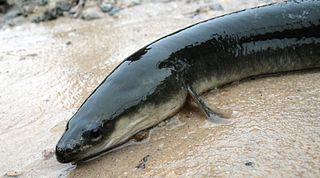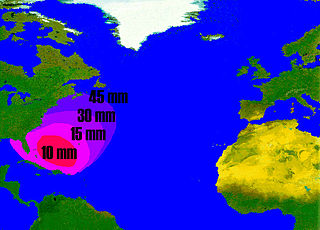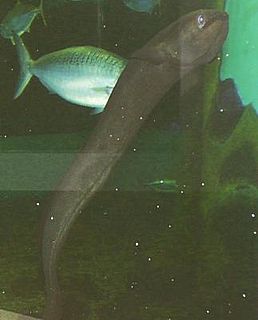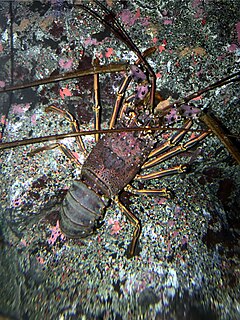
The European eel is a species of eel, a snake-like, catadromous fish. They can reach a length of 1.5 m in exceptional cases, but are normally around 60–80 cm (2.0–2.6 ft), and rarely reach more than 1 m.

The American eel is a facultative catadromous fish found on the eastern coast of North America. Eels are fish belonging to the elopomorph superorder, a group of phylogenetically ancient teleosts. The American eel has a slender snakelike body that is covered with a mucous layer, which makes the eel appear to be naked and slimy despite the presence of minute scales. A long dorsal fin runs from the middle of the back and is continuous with a similar ventral fin. Pelvic fins are absent, and relatively small pectoral fin can be found near the midline, followed by the head and gill-covers. Variations exist in coloration, from olive green, brown shading to greenish-yellow and light gray or white on the belly. Eels from clear water are often lighter than those from dark, tannic acid streams.

The eel is a long, thin bony fish of the order Anguilliformes. Because fishermen never caught anything they recognised as young eels, the life cycle of the eel was a mystery for a very long period of scientific history. Although more than 6500 publications mention eels, much of their life history remains an enigma.

The speckled longfin eel, Australian long-finned eel or marbled eel is one of 15 species of eel in the family Anguillidae. It has a long snake-like cylindrical body with its dorsal, tail and anal fins joined to form one long fin. It usually has a brownish green or olive green back and sides with small darker spots or blotches all over its body. Its underside is paler. It has a small gill opening on each side of its wide head, with thick lips. It is Australia's largest freshwater eel, and the female usually grows much larger than the male. It is also known as the spotted eel.

The Japanese spiny lobster, Panulirus japonicus, is a member of the genus Panulirus of spiny lobsters. It grows up to 30 centimetres (12 in) long and lives in the Pacific Ocean around Japan, China, and Korea. P. japonicus is the subject of commercial lobster fishery in Japan. It is a popular item in high-class Japanese cuisine. Serving and preparation methods include sashimi, as a steak, frying, and roasting alive.

Acetes is a genus of small shrimp that resemble krill, which is native to the western and central Indo-Pacific, the Atlantic coast of the Americas, Pacific coast of South America and inland waters of South America. Although most are from marine or estuarine habitats, the South American A. paraguayensis is a fresh water species. Several of its species are important for the production of shrimp paste in Southeast Asia, including A. japonicus, which is the world's most heavily fished species of wild shrimp or prawn in terms of total tonnage.
The Colocongridae, the worm eels or short-tail eels are a family of eels, containing a single genus, Coloconger.

Parribacus japonicus, the Japanese mitten lobster, is a species of slipper lobster. The Japanese name zōri-ebi (ゾウリエビ) refers to the zōri, a type of Japanese sandal, which it resembles in appearance. It lives in shallow water, up to 20 metres (66 ft) deep, around the southern coasts of Japan, from Maizuru and Tokyo Bay to the Ryūkyū Islands. It grows up to 16 centimetres (6.3 in) in total length, and is occasionally fished and sold for its meat.

South Korea occupies the southern portion of the Korean peninsula. The total land mass of the country is 98,480 km2 but usable land is only 20% of the total and thus the population is concentrated around the coast. The Korean Peninsula is surrounded by the East, West and South Seas, a coast-line that extends for about 2,413 km. Endowed with an abundance of fisheries resources, Koreans have developed a distinct seafood culture with annual per capita sea food consumption of 48.1 kg in 2005.

Ammodytes is a genus of sand lances native to the northern oceans.
Kaupichthys japonicus is an eel in the family Chlopsidae. It was described by Kiyomatsu Matsubara and Hirotoshi Asano in 1960. It was originally a subspecies of Kaupichthys diodontus. It is a tropical, marine eel which is known from Japan and the South China Sea, in the western Pacific Ocean. Males can reach a maximum total length of 23.8 cm. K. japonicus spawns in the summer.
Coloconger cadenati is an eel in the family Colocongridae. It was described by Robert H. Kanazawa in 1961. It is a marine, deep-water dwelling eel which is known from Senegal to the Gulf of Guinea in the eastern Atlantic Ocean. It is known from a depth range of 270–600 m. Males can reach a maximum total length of 90 cm. The diet of C. cadenati consists primarily of benthic crustaceans.
Coloconger canina is an eel in the family Colocongridae. It was described by Peter Henry John Castle and Solomon N. Raju in 1975. It is a marine, deep-water dwelling eel which is known from leptocephali collected from the Indian Ocean. It is known to dwell at a minimum depth of 300 m.
Coloconger eximia is an eel in the family Colocongridae. It was described by Peter Henry John Castle in 1967, originally under the genus Ascomana. It is a marine, deep-water dwelling eel which is known from Cape Peninsula, South Africa, in the southeastern Atlantic Ocean.
The giant leptocephalus is an eel in the family Colocongridae. It was described by Peter Henry John Castle in 1959. It is a marine, deep-water dwelling eel which is distributed worldwide.
Coloconger meadi is an eel in the family Colocongridae. It was described by Robert H. Kanazawa in 1957. It is a marine, deep-water dwelling eel from the Gulf of Mexico and Suriname in the western central Atlantic Ocean. It dwells at a depth range of 650–925 m. Males can reach a maximum total length of 37.7 cm.
The froghead eel is an eel in the family Colocongridae. It was described by Alfred William Alcock in 1889. It is a marine, deep-water dwelling eel which is known from the Indo-west Pacific, including East Africa, Madagascar, and southern Japan. It dwells at a depth range of 300–1134 metres. Males can reach a maximum total length of 50 centimetres.
Coloconger saldanhai is an eel in the family Colocongridae. It was described by J.C. Quéro in 2001. It is a marine eel which is known from New Caledonia.











